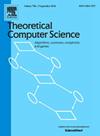Parameterizing path partitions
IF 0.9
4区 计算机科学
Q3 COMPUTER SCIENCE, THEORY & METHODS
引用次数: 0
Abstract
We study the algorithmic complexity of partitioning the vertex set of a given (di)graph into a small number of paths. The Path Partition problem (PP) has been studied extensively, as it includes Hamiltonian Path as a special case. The natural variants where the paths are required to be either induced (Induced Path Partition, IPP) or shortest (Shortest Path Partition, SPP), have received much less attention. Both problems are known to be -complete on undirected graphs; we strengthen this by showing that they remain so even on planar bipartite directed acyclic graphs (DAGs), and that SPP remains -hard on undirected bipartite graphs. When parameterized by the natural parameter “number of paths”, both SPP and IPP are shown to be -hard on DAGs. We also show that SPP is in both for DAGs and undirected graphs for the same parameter, as well as for other special subclasses of directed graphs (IPP is known to be -hard on undirected graphs, even for two paths). On the positive side, we show that for undirected graphs, both problems are in , parameterized by neighborhood diversity. We also give an explicit algorithm for the vertex cover parameterization of PP. When considering the dual parameterization (graph order minus number of paths), all three variants, IPP, SPP and PP, are shown to be in for undirected graphs. We also lift the mentioned neighborhood diversity and dual parameterization results to directed graphs; here, we need to define a proper novel notion of directed neighborhood diversity. As we also show, most of our results also transfer to the case of covering by edge-disjoint paths, and purely covering.
求助全文
约1分钟内获得全文
求助全文
来源期刊

Theoretical Computer Science
工程技术-计算机:理论方法
CiteScore
2.60
自引率
18.20%
发文量
471
审稿时长
12.6 months
期刊介绍:
Theoretical Computer Science is mathematical and abstract in spirit, but it derives its motivation from practical and everyday computation. Its aim is to understand the nature of computation and, as a consequence of this understanding, provide more efficient methodologies. All papers introducing or studying mathematical, logic and formal concepts and methods are welcome, provided that their motivation is clearly drawn from the field of computing.
 求助内容:
求助内容: 应助结果提醒方式:
应助结果提醒方式:


